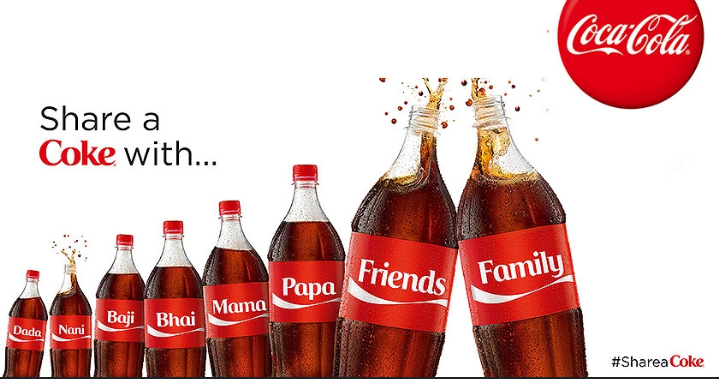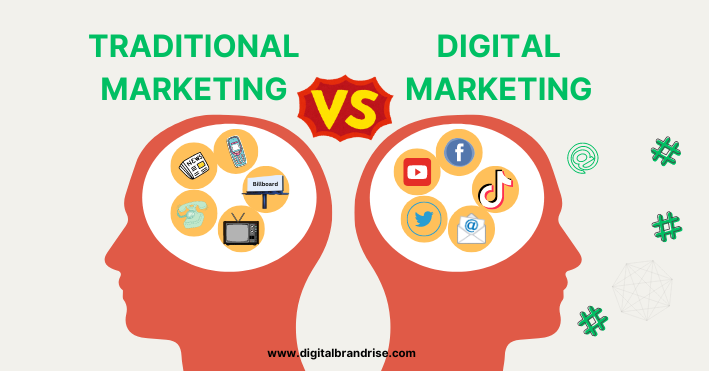A new way to think about traditional marketing vs. digital marketing!! Marketing has evolved significantly over the years, adapting to technological advancements and changes in consumer behavior. In today’s competitive landscape, choosing the right marketing strategy is crucial for business success. This blog aims to comprehensively compare traditional and digital marketing, helping you decide which approach suits your needs best.
What is Traditional Marketing?
Traditional marketing refers to the conventional methods of advertising and promotion used before the digital era. These methods focus on reaching a broad audience through offline channels.
Common Forms of Traditional Marketing
- Print: Newspapers, magazines, brochures, and flyers.
- TV: Commercials and infomercials broadcasted on television.
- Radio: Advertisements aired on radio stations.
- Billboards: Large outdoor signs placed in high-traffic areas.
- Direct Mail: Physical mail sent directly to consumers’ homes or businesses.
Advantages and Disadvantages of Traditional Marketing

What is Digital Marketing?
Digital marketing involves using online platforms and technologies to promote products and services. It leverages the internet to reach and engage with consumers.
Common Forms of Digital Marketing
- SEO: Optimizing website content to rank higher in search engine results.
- Content Marketing: Creating valuable content to attract and retain a target audience.
- Social Media: Promoting through platforms like Facebook, Twitter, Instagram, and LinkedIn.
- Email Marketing: Sending targeted emails to nurture leads and engage customers.
- PPC: Paying for ads that appear on search engines and other websites.
Advantages and Disadvantages of Digital Marketing

Key Differences Between Traditional and Digital Marketing

When to Use Traditional Marketing
Situations Where Traditional Marketing Excels
- Local Businesses: Effective for targeting local communities.
- Older Demographics: Reaching audiences less active online.
- Brand Building: Creating a strong, credible brand presence.
Case Studies/Examples of Successful Traditional Marketing Campaigns
Coca-Cola’s iconic TV commercials. In 2011, Coca-Cola launched one of its most iconic and successful marketing campaigns, “Share a Coke.” This innovative campaign began in Australia and quickly spread globally due to its unique approach and widespread appeal.

Local businesses use billboards to drive foot traffic by placing eye-catching advertisements in high-traffic areas.
For example, a local coffee shop in Seattle increased morning sales by 20% after advertising its “Buy One, Get One Free” offer on a billboard near a busy downtown intersection.
A family-owned Italian restaurant in New York saw a 30% increase in dinner reservations after promoting their “Kids Eat Free on Wednesdays” deal on billboards along major highways.
Similarly, a boutique clothing store in Los Angeles boosted weekend foot traffic by 25% by highlighting their “Summer Sale – Up to 50% Off” on billboards near popular shopping districts.
These successful examples demonstrate how well-placed billboards can significantly enhance a local business’s visibility and attract more customers.
When to Use Digital Marketing
Situations Where Digital Marketing Excels
- Online Businesses: Essential for e-commerce and online services.
- Young Demographics: Engaging tech-savvy, younger audiences.
- Measurable Campaigns: When precise tracking and analytics are needed.
Case Studies/Examples of Successful Digital Marketing Campaigns
Nike has mastered the art of social media marketing, leveraging platforms like Instagram, Twitter, and Facebook to engage millions of followers worldwide.
By creating compelling content that resonates with their audience, Nike’s campaigns often feature inspirational stories, professional athletes, and user-generated content.
Notable campaigns, such as “Just Do It” and “Dream Crazy,” have successfully captured the brand’s ethos and encouraged social media users to share their own stories of perseverance and achievement.
Through a combination of powerful storytelling, strategic influencer partnerships, and interactive content, Nike continues to build a strong, engaged online community, reinforcing its position as a leading global brand.

Combining Traditional and Digital Marketing
Integrated Marketing Strategies
Combining both approaches can maximize reach and impact. For example, a TV commercial might drive traffic to a website, where digital marketing strategies take over.
Benefits of Combining Both Approaches
- Broader Reach: Engages both offline and online audiences.
- Increased Credibility: Traditional methods enhance brand trust while digital methods drive engagement.
Real-World Examples of Successful Integrated Campaigns
Coca-Cola’s “Share a Coke” campaign used TV ads, social media, and personalized bottles to create a cohesive and engaging experience.
Industry-Specific Considerations
How Different Industries Might Benefit
- Retail: Combines in-store promotions with online sales.
- Healthcare: Uses traditional methods for credibility and digital for patient engagement.
- Real Estate: Blends direct mail with digital listings and virtual tours.
Factors to Consider Based on Business Type, Target Audience, and Goals
Evaluate your industry, audience preferences, and specific goals to determine the right balance between traditional and digital marketing.
Future Trends in Marketing
Emerging Trends in Both Traditional and Digital Marketing
- Traditional: Increased use of interactive billboards and print ads with QR codes.
- Digital: Growth of AI-driven marketing, personalized content, and influencer collaborations.
Predictions for the Future of Marketing Strategies
- Continued integration of traditional and digital methods.
- Enhanced focus on personalized and immersive experiences.
Conclusion
Traditional marketing offers tangible, broad-reach methods but comes with higher costs and limited measurability. Digital marketing provides cost-effective, targeted, and measurable strategies with higher engagement. Assess your business needs, audience, and goals to determine the best mix of traditional and digital marketing.
FAQs (Frequently Asked Questions)
Q: Is digital marketing better than traditional marketing?
A: It depends on your goals, audience, and budget. Each has its strengths and can complement each other.
Q: Can small businesses benefit from traditional marketing?
A: Yes, especially for local businesses looking to build a community presence.
Q: How can I measure the success of my marketing campaigns?
A: Digital marketing provides robust analytics tools, while traditional methods can use surveys, sales data, and tracking codes.




